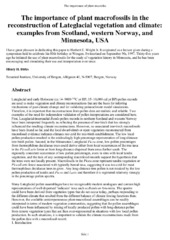The importance of plant macrofossils in the reconstruction of Lateglacial vegetation and climate: examples from Scotland, western Norway, and Minnesota, USA
Peer reviewed, Journal article
Permanent lenke
http://hdl.handle.net/1956/387Utgivelsesdato
2003-03Metadata
Vis full innførselSamlinger
Originalversjon
https://doi.org/10.1016/s0277-3791(02)00248-2Sammendrag
Lateglacial and early Holocene (ca 14–9000 14C yr BP; 15–10,000 cal yr BP) pollen records are used to make vegetation and climate reconstructions that are the basis for inferring mechanisms of past climate change and for validating palaeoclimate model simulations. Therefore, it is important that reconstructions from pollen data are realistic and reliable. Two examples of the need for independent validation of pollen interpretations are considered here. First, Lateglacial-interstadial Betula pollen records in northern Scotland and western Norway have been interpreted frequently as reflecting the presence of tree-birch that has strongly influenced the resulting climate reconstructions. However, no associated tree-birch macrofossils have been found so far, and the local dwarf-shrub or open vegetation reconstructed from macrofossil evidence indicates climates too cold for tree-birch establishment. The low local pollen production resulted in the misleadingly high percentage representation of long-distance tree-birch pollen. Second, in the Minnesotan Lateglacial Picea zone, low pollen percentages from thermophilous deciduous trees could derive either from local occurrences of the tree taxa in the Picea/Larix forest or from long-distance dispersal from areas further south. The regionally consistent occurrence of low pollen percentages, even in sites with local tundra vegetation, and the lack of any corresponding macrofossil records support the hypothesis that the trees were not locally present. Macrofossils in the Picea zone represent tundra vegetation or Picea/Larix forest associated with typically boreal taxa, suggesting it was too cold for most thermophilous deciduous trees to grow. Any long-distance tree pollen is not masked by the low pollen production of tundra and Picea and Larix and therefore it is registered relatively strongly in the percentage pollen spectra. Many Lateglacial pollen assemblages have no recognisable modern analogues and contain high representations of well-dispersed ‘indicator’ taxa such as Betula or Artemisia. The spectra could have been derived from vegetation types that do not occur today, perhaps responding to the different climate that resulted from the different balance of climate forcing functions then. However, the available contemporaneous plant-macrofossil assemblages can be readily interpreted in terms of modern vegetation communities, suggesting that the pollen assemblages could have been influenced by mixing of locally produced pollen with long-distance pollen from remote vegetation types that are then over-represented in situations with low local pollen production. In such situations, it is important to validate the climate reconstructions made from the pollen data with a macrofossil record.
